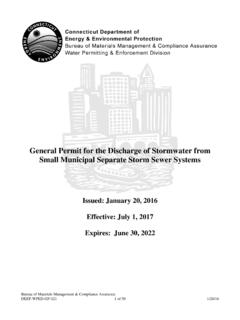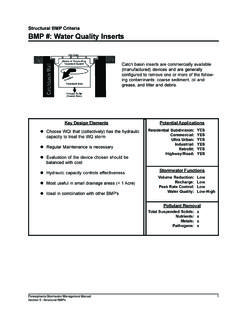Transcription of Management, Operations, and Maintenance of Tributary Sewers
1 Chapter 3 Management, Operations, and Maintenance of Tributary Sewers Subchapter I - General Subchapter IV - Enforcement Purpose ..1 Types of enforcement actions ..20 Applicability ..1 Orders ..20 Sewer extension moratorium ..20 Preservation of local authority ..2 Fees for excessive infiltration Capacity assurance, management, inflow, or peak flows ..21 operations, and Maintenance Special provisions related to programs ..2 draining surface water to District review ..4 sanitary Sewers ..21 Prohibited connections ..5 Administrative review ..21 Foundation Inflow prevention ordinances ..6 Inspections ..7 Prohibited connection enforcement.
2 7 Submerged manholes ..8 Draining surface water to sanitary Sewers ..8 Debris from sewer and street cleaning .8 Technical advisory team consultation ..9 Other action ..10 PCBs in Sewers to be cleaned ..10 Roof drain disconnection Subchapter II Peak Flow Rate Reduction Metersheds where peak flow rate reduction is required ..16 Peak hourly flow rate reduction program ..16 Subchapter III - Reports Annual report ..18 Compliance Maintenance annual report ..19 1 Subchapter I - General Purpose The purpose of this chapter is to ensure that all Sewers Tributary to the District s sewerage system, including all public and private Sewers and all connections to them, are managed, operated, and maintained to: (1) maximize the efficiency and effectiveness of conveyance and treatment facilities; (2) minimize the probability, duration, and magnitude of overflows; and (3) reduce the exposure of the public to pathogens carried by wastewater.
3 Applicability This chapter applies to any person or governmental unit who owns or operates a sewer Tributary to the District s sewerage system or any connection to a Tributary sewer. Definitions (1) 2020 Facilities Plan means the facilities plan completed by the District, as accepted by the Department, for the period up to the year 2020. (2) Building sewer has the meaning established by sec. COMM (44), Wis. Adm Code. A building sewer is also known as a lateral sewer, according to sec. , MMSD Rules. (3) Department means the Wisconsin Department of Natural Resources. (4) Facilities plan means a plan prepared according to sec. NR , Wis. Adm. Code. (5) Local sewer system plans means plans prepared according sec.
4 , MMSD Rules. (6) Private interceptor main sewer has the meaning established by sec. COMM (193), Wis. Adm. Code. (7) Sanitary metershed means the geographical area served by a system of building Sewers , private interceptor main Sewers , and public sanitary Sewers that drain to a common monitoring point. (8) Sanitary sewershed means the geographical area served by a system of building Sewers , private interceptor main Sewers , and public sanitary Sewers that drain to a common outlet. Adopted August 18, 1982; Repealed and recreated September 28, 1998; Repealed and recreated May 21, 2007; Amended December 17, 2007; Amended January 25, 2010; Amended May 19, 2014 2 (9) Technical Advisory Team means a group organized by the District consisting of technical staff from governmental units within the District s service area, the Department of Natural Resources, and the Southeastern Wisconsin Regional Planning Commission, and the District.
5 (10) WPDES means the Wisconsin Pollutant Discharge Elimination System, as established by ch. 283, Wis. Stats. Preservation of Local Authority (1) The preemptive effect of this chapter is limited to requirements that directly conflict with this chapter. Governmental units may establish requirements that are more stringent or more detailed, that provide greater environmental protection, or that improve the level of service provided by the sewerage system. Governmental units may seek any penalty authorized by law in addition to the minimum penalties established in this chapter. (2) Governmental units retain discretion for the operation and Maintenance of the Tributary Sewers that they own or operate, as required by sec.
6 , Wis. Stats. Governmental units are solely responsible for compliance with all applicable WPDES permits, regulations, and any other relevant provisions of local, state or federal law. The District s responsibilities are limited to the regulatory activities necessary to achieve the regional goals established by sec. Capacity Assurance, Management, Operations, and Maintenance Programs (1) No later than June 30, 2009, governmental units shall establish systematic and proactive programs for capacity assurance, management, operation, and Maintenance for their sewerage systems. Governmental units shall: (a) maintain local sewer system plans for all public sanitary Sewers and private interceptor main Sewers .
7 (b) maintain records of the physical attributes and the condition of all public sanitary Sewers and ancillary facilities. (c) pro-actively clean public sanitary Sewers and ancillary facilities and remove accumulations of debris. (d) pro-actively assess the condition and performance of public sanitary Sewers and ancillary facilities, using the system established by the Pipeline Assessment and Certification Program Reference Manual (National Association of Sewer Service Companies (2001)), unless the District has approved an alternative system. Adopted August 18, 1982; Repealed and recreated September 28, 1998; Repealed and recreated May 21, 2007; Amended December 17, 2007; Amended January 25, 2010; Amended May 19, 2014 3 (e) pro-actively repair, replace, and rehabilitate public sanitary Sewers and ancillary facilities, based upon condition and performance.
8 (f) provide sufficient personnel, such as engineering, operations, Maintenance , inspection, planning, geographic information systems, budget, accounting, and finance, and provide these personnel with adequate information, equipment, and training. (g) adopt, implement, and enforce an inflow prevention ordinance, as required by sec. (h) develop and implement a program management plan, which shall include: a mission statement, goals, objectives, strategies, performance measures, data types and sources, personnel, budget, and chains of command. (i) develop and implement overflow response and emergency response plans. The overflow response plan shall include procedures for identifying local overflows, mitigating their duration and volume, identifying their cause, determining the actions necessary to prevent their recurrence, and notifying the District.
9 The emergency response plan shall include procedures for identifying the location and type of an emergency, notifying appropriate personnel, mitigating adverse affects, and implementing corrective action. Emergencies to be covered include, but are not limited to, basement flooding, chemical spills, and equipment failure during dry weather. (j) develop and implement a communications plan, which shall indicate when, how, and by whom the governmental unit will provide information regarding the work required by this chapter to both internal stakeholders, such as the governmental unit s employees and governing bodies, and external stakeholders, such as the District. This plan shall provide for an annual report, which shall describe progress towards the objectives identified in the management plan.
10 This plan shall also provide for any reports required by local, state, or federal law. (k) develop and implement an audit plan, which shall provide for rigorous periodic evaluation of the actions required by this chapter at least once every five years, including input from internal and external stakeholders. (l) 1. prepare a system evaluation and capacity assurance plan, if hydraulic information is necessary to evaluate a sewer design decision or understand sewer performance. The plan shall estimate peak flows, estimate the capacity of critical system components, identify hydraulic deficiencies, evaluate alternatives for corrective action, prioritize corrective action, and establish an implementation schedule.

